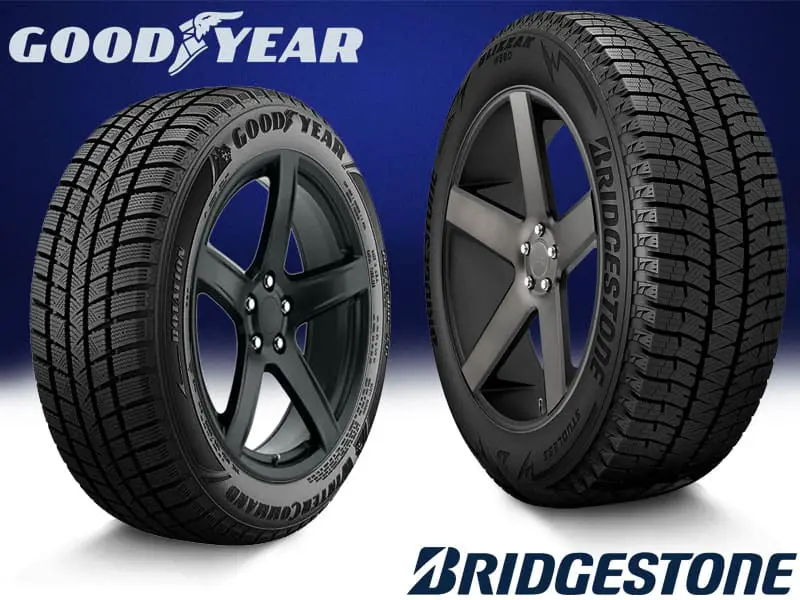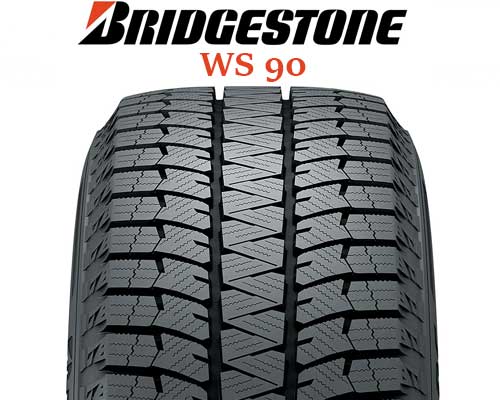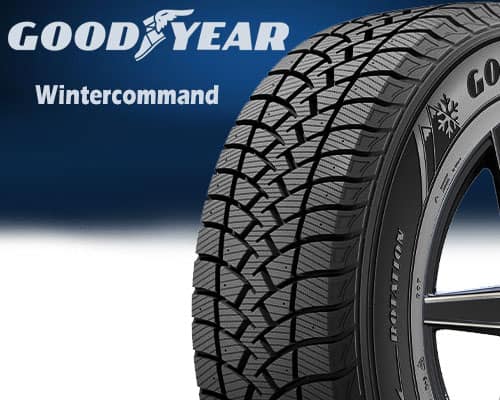Bridgestone Blizzak WS90 and Goodyear Wintercommand are both winter tires especially built for driving comfortably in the cold season even in areas where ice or snow present a lot of trouble for regular all-season tires. WS90 comes from the Blizzak series, which is famous for its exceptional winter performance, comparatively, we found it is superior on snow while also providing an outclass experience on a dry road.
On the other side, Wintercommand shows optimum traction on the wet and icy surface and offers a confident performance in snow. Find out below in the article that which one has better fuel average.

Table of Contents
Comparing WS90 with Goodyear WinterCommand

Vs

The Bridgestone Blizzak WS90 tread characterizes a symmetrical and directional design consisting of a central, crisscross rib which continues circumferentially without any lateral spacing, two main grooves along its sides, two disjointed grooves formed by traction notches over the shoulder lugs, and multidirectional, zigzag sipes. A low void ratio makes the contact patch of tread higher and leads to better grip and stabilized handling over dry paved roads. On the wet and icy surface, voids and sipes provide hydroplaning resistivity, however, its wiping efficiency is a bit lower than its competitor due to fewer and shallower grooves. Its grooves have a good capacity to evacuate snow, moreover, it is favored by specialized tread composition in terms of snow traction.
Goodyear Wintercommand also exhibits a symmetrical and directional tread with a continuous central rib but it has less width in comparison. Two ribs formed by square-shaped blocks and two circumferential grooves are present on each side of the central rib. This arrangement leads to a high void ratio and minimizes contact patch which eventually decreases the dry grip of the tread. On the other side, it shows better grip, as well as fully controlled steer response on a wet road as higher number of deeper voids and full depth sipes, provide space for water to move out quickly and prevent aquaplaning. While roaming about snowy areas, its deeper channels have an efficient biting capacity to hold on to the soft snow and clear themselves while moving ahead, yet losses to its competitor.
FYI: You can compare Bridgestone Blizzak with Michelin X ICE tires as well.
Road Grip Comparison
WS90 shows superior grip on dry paved track because its continuous central rib which does not have any horizontal void and narrow grooves overall makes its contact patch comparatively greater, as a result, its tread can hold on to the surface more strongly. On the wet road, it offers dependable traction as its zigzag sipes and grooves wipe the water away, however, it not only has fewer grooves but also the depth of its channels is lower in comparison which leads to relatively minimized wet grip. Over snow both tires come head-to-head due to their characteristic features, WS90 seems winning here because its tread rubber is made from NanoPro Multicell compound which has bite particles and hydrophilic characters for supreme traction on snow-packed ways but lacks the grip on ice due to shallow sipes which are unable to grip ice firmly even with the higher contact patch.
On the other side, the high void ratio of Wintercommand decreases the area of its tread in contact with the road, leading to relatively lesser grip on a dry road. Conversely, it shows superior grip on the wet because it has an increased number of deeper grooves and full-depth zigzag sipes which provide more water holding capacity in comparison. On the ice, the tire outperforms its rival due to the better grip provided by intense sipes even with a lower contact patch. In snow-packed areas, its deep voids offer good evacuation of snow backward and give tough competition to its opponent in terms of snow traction, however, it stands below because it lacks microscopic bite particles for additional grip over snow.
Handling Comparison
On a dry road, WS90 provides a fully commanded steer response as its shoulders take the load proficiently while moving along a corner because of its higher contact patch. Traction notches over lugs further enhance the biting ability and improve its dry handling. While turning over the wet or icy surface, its lateral grooves and sipes do wipe the water away from tread but it has lesser competence in this respect as compared to the competitor because its void ratio is comparatively low. In snow, lateral grooves provide snow evacuation and play their key role in maintaining firm traction while turning about, moreover, snow handling efficiency is made superior to its competitor due to enhanced biting ability provided by NanoPro bite particles present in tread rubber.
Wintercommand stands behind in the competition for steer handling over dry paved paths because small, squared shoulder lugs have less contact patch to hold on the surface while turning, moreover, it also lacks traction notches to enhance biting capacity on dry roads. On the other side, it provides good wet handling owing to relatively deeper grooves among shoulder blocks which are also marked with full depth sipes and remove water present on the surface, accounting for firm handling while taking turns over the slippery surface like a wet road or icy lane. On a snow-covered path, deep voids bite firmly as the vehicle turns around, however, it’s handling in the snow is made less in comparison as it is deprived of bite particles for enhanced snow traction.
Comparison of Hydroplaning Resistance
Both tires have a reliable capacity to resist aquaplaning over slippery roads owing to grooves and sipes. However, WS90 stands behind its competitor as it has fewer narrow grooves whose depths are also lesser than the competitor’s, hence, it offers comparatively lesser space for the removal of water.
Wintercommand shows superior hydroplaning resistivity as water wiping ability is contributed not only by full depth sipes but also by four broad and deeper grooves, leaving no chance of hydroplaning.
Comparison of Rolling Resistance
As Blizzak has a relatively higher contact patch, hence, more hysteresis (energy loss) is produced when it rolls over the road, thus, the value of rolling resistance is quite high. Consequently, a large amount of fuel is consumed by this tire.
Wintercommand faces minimal rolling resistance as less surface area of its tread is in contact with the road and less energy is used to compensate for the hysteresis produced while moving ahead. Hence, it shows a better fuel average than its competitor.
Comfort and Noise Comparison
WS90 offers a quieter driving experience on road due to its low void ratio. The small number of relatively narrow grooves minimize capturing of noisy particles among tread channels, as a result, less noise is produced. High contact patch makes it more comfortable over the dry road while a low void ratio makes it less comfortable on a wet road.
The high void ratio makes Wintercommand a relatively loud tire. Its deep and linear grooves provide broad space for the reflection of air particles and make a lot of noise while moving at high speed. It provides relatively less comfort on dry track due to decreased contact patch, however, the reverse is true for driving over wet pavement due to many deeper grooves.
Durability and tread wear
Winter tires are usually less durable because of their softer tread rubber, likewise, are these two tires. WS90 faces more rolling resistance due to the high contact patch and its tread starts wearing even faster after consumption of the first layer. Its dual compound structuring includes upper 55% of NanoPro tech multicell compound containing microscopic bite particles and a hydrophilic coating for supreme snow traction while lower 45% is Bridgestone’s winter tire compound which is comparatively softer.
No one of these has a mileage warranty from the manufacturer. In comparison, Wintercommand lasts a bit longer because it faces low rolling resistance as its contact patch is minimized due to the high void ratio.
Price
Wintercommand is a more beneficial option, economically as it is priced lower than its competitor and has a relatively better fuel average and durability as well.
The higher price of WS90 is justified by its supreme abilities over snow.
Quick Summary
- Bridgestone Blizzak WS90 and Goodyear Wintercommand are both winter tires.
- WS90 gives superior performance in terms of dry traction while Wintercommand shows better-wet traction.
- On snow-covered paths, Blizzak offers enhanced stability while Wintercommand excels on ice.
- WS90 faces more rolling resistance and makes less noise.
- Wintercommand costs lesser and lasts longer in comparison.